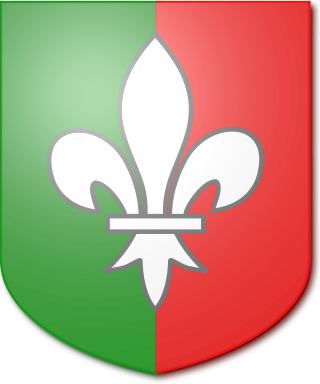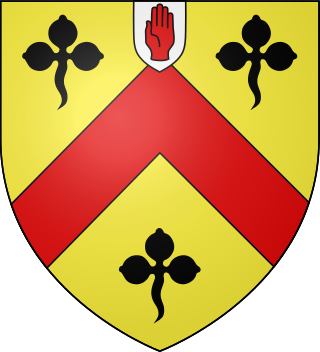
Viscount Hardinge, of Lahore and of Kings Newton in the County of Derby, is a title in the Peerage of the United Kingdom. It was created in 1846 for the soldier and Tory politician Sir Henry Hardinge. His son, the second Viscount, represented Downpatrick in Parliament. His great-great-grandson, the sixth Viscount, succeeded a distant relative as eighth Baronet, of Belle Isle in the County of Fermanagh, in 1986. This title had been created in the Baronetage of the United Kingdom 1801 for Richard Hardinge. He was the third son of Nicolas Hardinge, younger brother of Reverend Henry Hardinge and uncle of the latter's third son Henry Hardinge, 1st Viscount Hardinge. The baronetcy was created with special remainder to the heirs male of Richard Hardinge's father.

The Eliott Baronetcy, of Stobs in the County of Roxburgh, is a title in the Baronetage of Nova Scotia. It was created on 3 December 1666 for Gilbert Eliott. The second baronet was a member of the pre-union Parliament of Scotland. The third Baronet sat as Member of Parliament for Roxburghshire. The Eliott Baronets share a common early Elliot ancestry with the nearby Earls of Minto (Elliot). It is thought that the surname spelling differences were contrived to differentiate the branches.

The Anson baronetcy, of Birch Hall in the County Palatine of Lancaster, is a title in the Baronetage of the United Kingdom held by a branch of the Anson family.

The Bunbury Baronetcy, of Bunbury, Oxon and Stanney Hall in the County of Chester, is a title in the Baronetage of England. It was created on 29 June 1681 for Thomas Bunbury, Sheriff of Cheshire from 1673 to 1674 and the member of an ancient Cheshire family. His grandson, Henry, the third Baronet, and great-grandson, the fourth Baronet, both sat as Members of Parliament for Chester. The latter died unmarried at an early age and was succeeded by his younger brother, the fifth Baronet. He was a clergyman. On his death in 1764 the title passed to his eldest son, the sixth Baronet. He represented Suffolk in the House of Commons for over forty years but is best remembered for his marriage to Lady Sarah Lennox. He died childless in 1821 and was succeeded by his nephew, the seventh Baronet. He was the son of Henry Bunbury, younger son of the fifth Baronet. The seventh Baronet was a distinguished soldier and politician. His eldest son, the eighth Baronet, was High Sheriff of Suffolk in 1868, and Fellow of the Royal Society. He died childless in 1886 and was succeeded by his younger brother, the ninth Baronet. He was Liberal Member of Parliament for Bury St Edmunds. He died unmarried in 1895 and was succeeded by his nephew, the tenth Baronet. He was the son of Colonel Henry William St Pierre Bunbury, third son of the seventh Baronet. He served as High Sheriff of Suffolk in 1908 and was a Deputy Lieutenant of the county. On his death in 1930 the title passed to his son, the eleventh Baronet. He was High Sheriff of Suffolk in 1936 and was a Deputy Lieutenant of the county. His son, the twelfth Baronet, was High Sheriff of Suffolk in 1972. As of 2014 the title was held by the latter's second but eldest surviving son, the thirteenth Baronet, who succeeded in 1985.
The Langham Baronetcy, of Cottesbrooke in the County of Northampton, is a title in the Baronetage of England. It was created on 7 June 1660 for John Langham, Member of Parliament for the City of London in 1654 and for Southwark in 1660 and 1661. The second Baronet was Member of Parliament for Northamptonshire and Northampton while the third Baronet sat for Northampton. The seventh Baronet was Member of Parliament for Northamptonshire. The tenth Baronet represented St Germans in the House of Commons. The thirteenth Baronet was a photographer, ornithologist and entomologist and served as High Sheriff of County Fermanagh in 1930.

There have been two baronetcies created for the Guise family, one in the Baronetage of England and one in the Baronetage of Great Britain. The latter creation is extant as of 2014.

The Hogg, later Lindsay-Hogg Baronetcy, of Rotherfield Hall in Rotherfield in the County of Sussex, is a title in the Baronetage of the United Kingdom. It was created on 22 December 1905 for Lindsay Hogg, Conservative Member of Parliament for Eastbourne from 1900 to 1906. He assumed by Royal licence the additional surname of Lindsay before that of Hogg in 1906.

The Leeds Baronetcy, of Croxton Park in the County of Cambridge, is a title in the Baronetage of the United Kingdom. It was created on 31 December 1812 for George Leeds. He was an equerry to Prince Augustus Frederick, Duke of Sussex. The Croxton Park estate in Cambridgeshire had been in the Leeds family since circa 1568. As of 2011 the presumed ninth and present Baronet, a resident of Canada, has not successfully proven his succession and is not on the Official Roll of the Baronetage.

The Lechmere Baronetcy, of The Rhydd in the County of Worcester, is a title in the Baronetage of the United Kingdom. It was created on 10 December 1818 for Anthony Lechmere. The second Baronet served as High Sheriff of Worcestershire in 1852. The third Baronet was high sheriff in 1862 and from 1866 was Conservative Member of Parliament for Tewkesbury, Worcestershire West, Bewdley and Worcestershire South. The sixth Baronet served as high sheriff in 1962 and as Vice-Lieutenant of Herefordshire and Worcestershire in 1977. In 2001 the title was inherited by his cousin and, as of 2017, the title is held by the latter's son, the eighth Baronet, who succeeded in 2010 and was high sheriff of Worcestershire in 2016.

The Farrington Baronetcy, of Blackheath in the County of Kent, is a title in the Baronetage of the United Kingdom. It was created on 2 December 1818 for General Sir Anthony Farrington, 1st Baronet.
The Lacon Baronetcy, of Great Yarmouth in the County of Norfolk, is a title in the Baronetage of the United Kingdom. It was created on 11 December 1818 for Edmund Lacon. The second Baronet was High Sheriff of Norfolk. The third Baronet sat as Conservative Member of Parliament for Great Yarmouth and Norfolk North. The family seat has been Ormesby House in Ormesby St Michael.

The ffolkes Baronetcy, of Hillington in the County of Norfolk, is a title in the Baronetage of Great Britain. It was created on 26 May 1774 for Martin ffolkes, FRS later High Sheriff of Norfolk and Member of Parliament for King's Lynn. The second Baronet represented Norfolk and Norfolk West in the House of Commons while the third Baronet represented King's Lynn. The fifth Baronet was Honorary Chaplain to Queen Victoria, Chaplain-in-Ordinary to Edward VII and George V and Chaplain to Edward VIII and George VI.

The Winnington Baronetcy, of Stanford Court in the County of Worcester, is a title in the Baronetage of Great Britain.

The Hoghton or Houghton, later Bold-Hoghton, later de Hoghton Baronetcy, of Hoghton Tower in the County of Lancashire, is a title in the Baronetage of England. It was created on 22 May 1611 for Richard Hoghton, Member of Parliament for Lancashire. The Hoghton family had been landowners in Lancashire since the reign of King Stephen and had been Knights of the Shire for Lancashire since the 14th century. The second Baronet represented Clitheroe and Lancashire in the House of Commons and was a Royalist leader during the Civil War. The third and fourth Baronets both sat as Members of Parliament for Lancashire. The fifth Baronet was Member of Parliament for Preston and East Looe while the sixth and seventh Baronets represented Preston. The eighth Baronet assumed the additional surname of Bold. In 1892 the ninth Baronet resumed, by Royal licence, the ancient family surname of de Hoghton.
The Jervoise, later Clarke-Jervoise Baronetcy, of Idsworth in the County of Southampton, was a title in the Baronetage of the United Kingdom. It was created on 13 November 1813 for Rev. Samuel Jervoise, born Samuel Clarke, who assumed the surname of Jervoise by royal licence in 1808.

The Abdy Baronetcy, of Albyns, in the County of Essex, was created in the Baronetage of the United Kingdom on 22 December 1849 for Thomas Neville Abdy who sat for Lyme Regis in the British House of Commons. It was a second creation for the seat: see Abdy baronets of Albyns (1660).
The Sullivan baronetcy, of Thames Ditton in the County of Surrey, was created in the Baronetage of the United Kingdom on 22 May 1804 for the writer and MP Richard Sullivan. The third and sixth Baronets were Admirals in the Royal Navy. The ninth holder of the baronetcy did not use his title; as of 2023 the Official Roll marked the baronetcy as vacant.
The Scott baronetcy, of the Yews in the County of Westmorland, was created in the Baronetage of the United Kingdom on 27 July 1909 for the businessman James William Scott. His grandson Sir Oliver Scott, 3rd baronet, was a Cambridge MD who worked as a Radiobiologist in cancer therapy research.

The Waller baronetcy, of Newport in the County of Tipperary, was created in the Baronetage of Ireland on 1 June 1780 for Robert Waller, Member of the Irish Parliament for Dundalk and a Commissioner of Revenue. The 2nd Baronet served as High Sheriff of King's County in 1826.

The Munro baronetcy, of Foulis in the County of Ross, was created in the Baronetage of Nova Scotia on 7 June 1634 for Colonel Hector Monro, with remainder to his heirs male whatsoever. On the death of his son, the 2nd Baronet, in 1651, the male line of the first Baronet failed and the title was inherited by Robert Munro, grandson of George Munro, uncle of the 1st Baronet.















